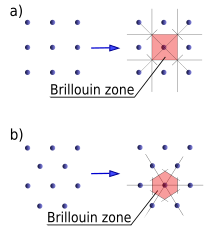
Back منطقة بريليون Arabic Зона Брылюэна Byelorussian ব্রিলুইন জোন Bengali/Bangla Zona de Brillouin Catalan Brillouin-Zone German Zona de Brillouin Spanish Brillouinin vyöhyke Finnish Zone de Brillouin French אזור ברילואן HE Brillouin-zóna Hungarian

In mathematics and solid state physics, the first Brillouin zone (named after Léon Brillouin) is a uniquely defined primitive cell in reciprocal space. In the same way the Bravais lattice is divided up into Wigner–Seitz cells in the real lattice, the reciprocal lattice is broken up into Brillouin zones. The boundaries of this cell are given by planes related to points on the reciprocal lattice. The importance of the Brillouin zone stems from the description of waves in a periodic medium given by Bloch's theorem, in which it is found that the solutions can be completely characterized by their behavior in a single Brillouin zone.
The first Brillouin zone is the locus of points in reciprocal space that are closer to the origin of the reciprocal lattice than they are to any other reciprocal lattice points (see the derivation of the Wigner–Seitz cell). Another definition is as the set of points in k-space that can be reached from the origin without crossing any Bragg plane. Equivalently, this is the Voronoi cell around the origin of the reciprocal lattice.


There are also second, third, etc., Brillouin zones, corresponding to a sequence of disjoint regions (all with the same volume) at increasing distances from the origin, but these are used less frequently. As a result, the first Brillouin zone is often called simply the Brillouin zone. In general, the n-th Brillouin zone consists of the set of points that can be reached from the origin by crossing exactly n − 1 distinct Bragg planes. A related concept is that of the irreducible Brillouin zone, which is the first Brillouin zone reduced by all of the symmetries in the point group of the lattice (point group of the crystal).
The concept of a Brillouin zone was developed by Léon Brillouin (1889–1969), a French physicist.[2]
Within the Brillouin zone, a constant-energy surface represents the loci of all the -points (that is, all the electron momentum values) that have the same energy. Fermi surface is a special constant-energy surface that separates the unfilled orbitals from the filled ones at zero kelvin.
- ^ "Topic 5-2: Nyquist Frequency and Group Velocity" (PDF). Solid State Physics in a Nutshell. Colorado School of Mines.
- ^ Brillouin, L. (1930). "Les électrons libres dans les métaux et le role des réflexions de Bragg" [Free electrons in metals and the role of Bragg reflections]. Journal de Physique et le Radium (in French). 1 (11). EDP Sciences: 377–400. doi:10.1051/jphysrad:01930001011037700. ISSN 0368-3842.
© MMXXIII Rich X Search. We shall prevail. All rights reserved. Rich X Search
